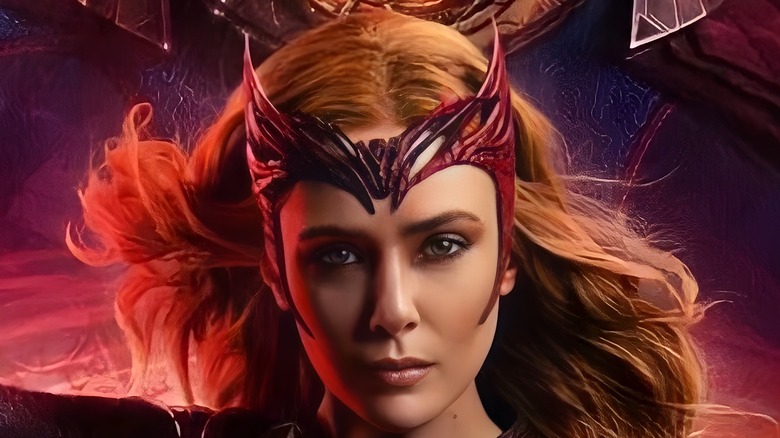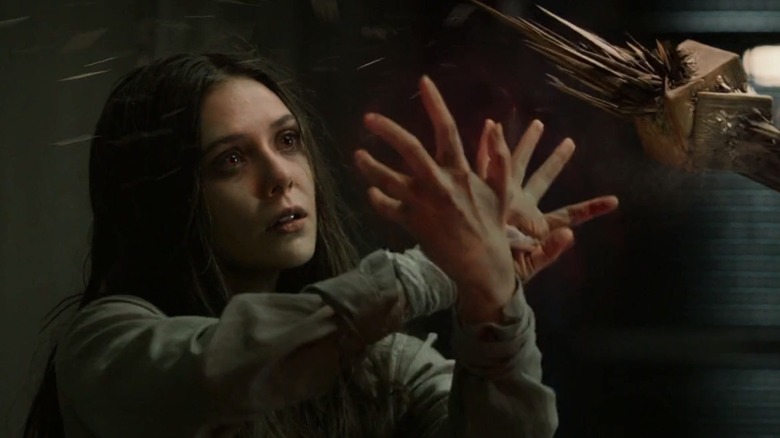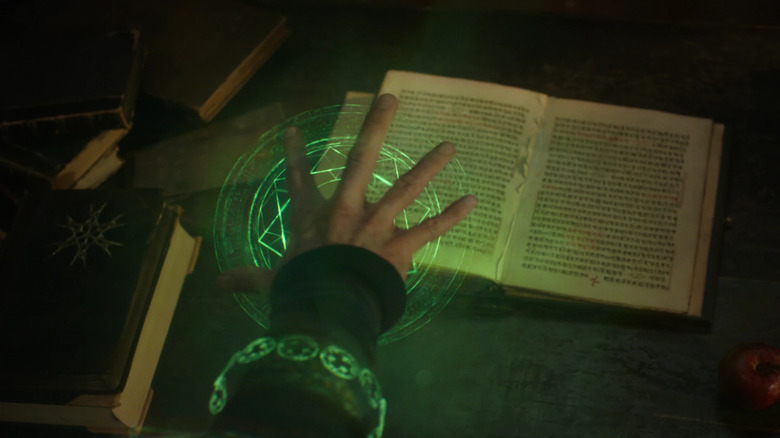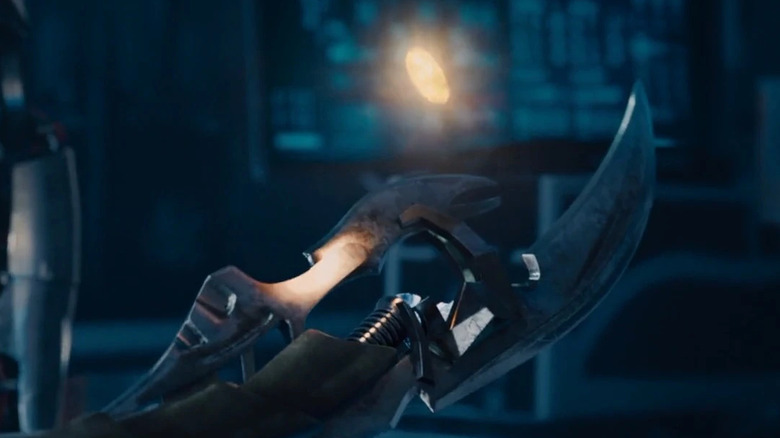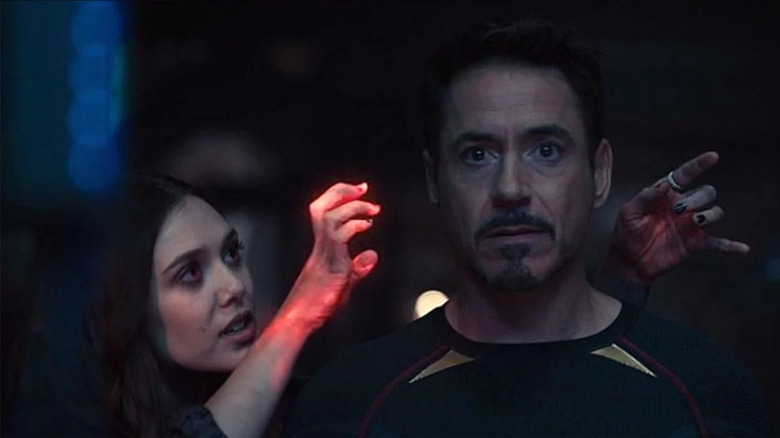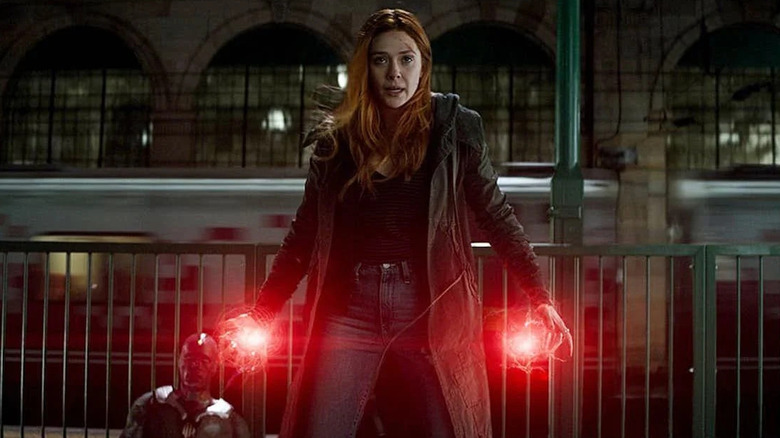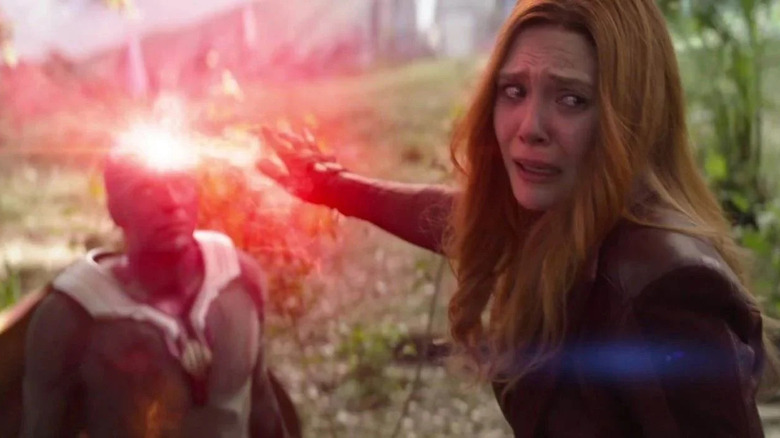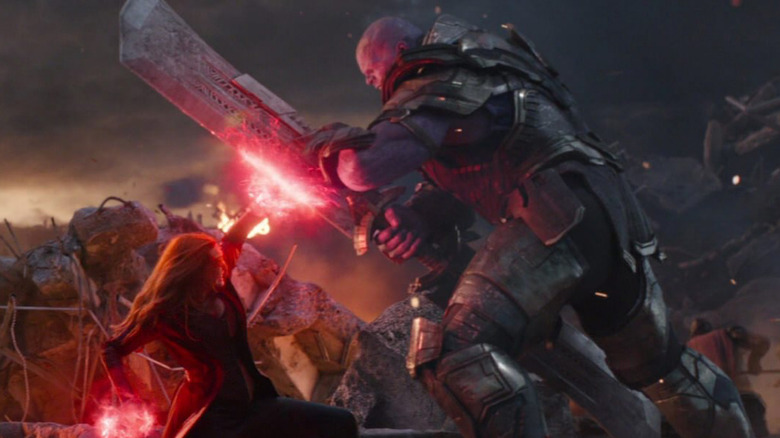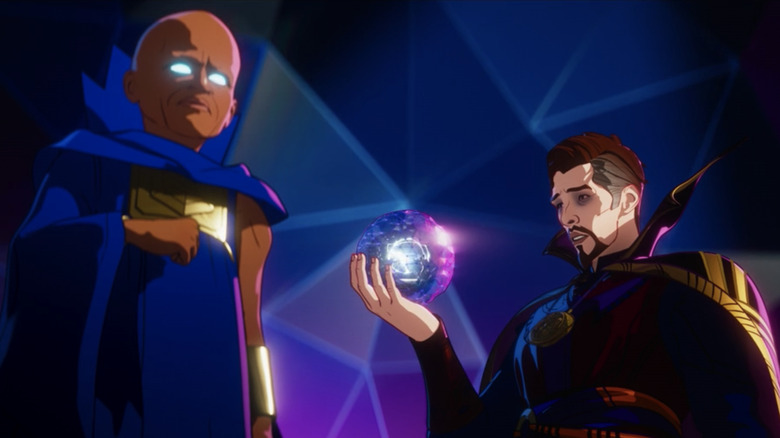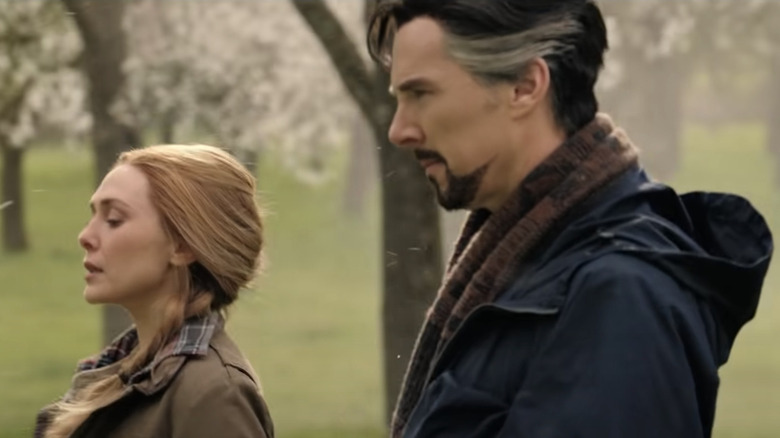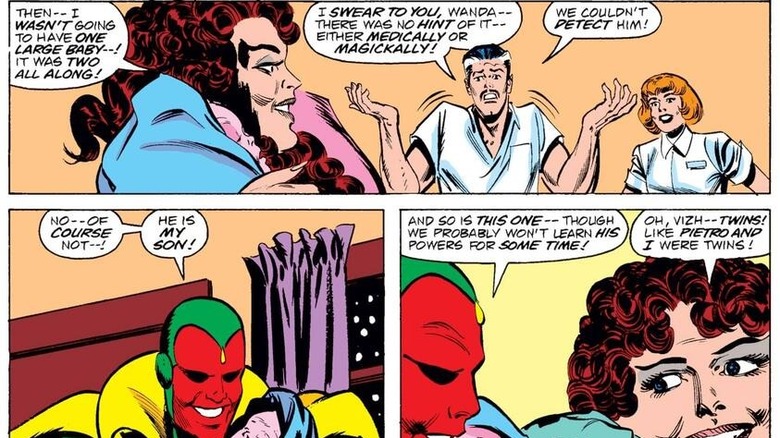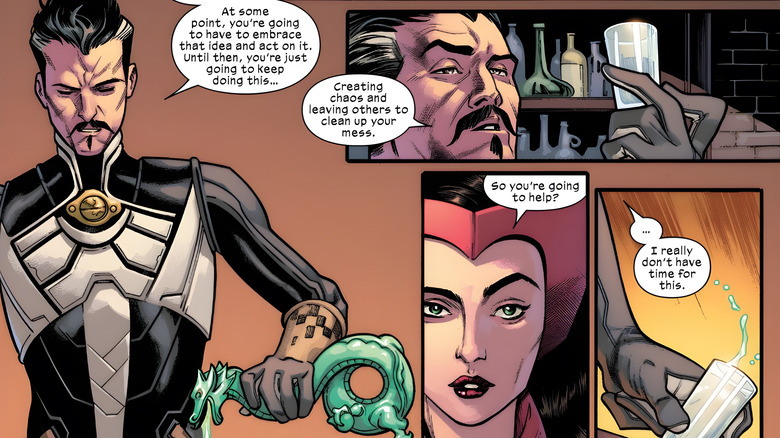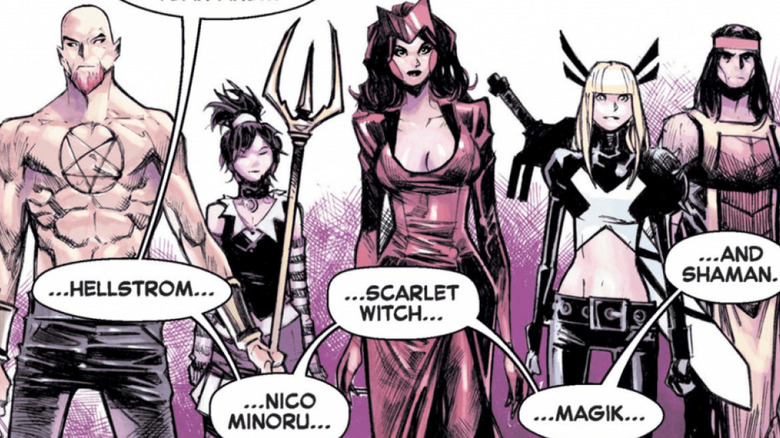The Relationship Between Doctor Strange And Scarlet Witch Explained
With its ever-expanding lineup of movies and TV shows, the MCU has by now amassed an impressive roster of bizarre and brilliant magic users. Whether they're well-versed wizards like Wong, godly avatars like Moon Knight, or even a god themselves like Loki, the cinematic universe is well-stocked with every manner of magic user you can imagine. But even as that universe becomes a multiverse, two sorcerers stand out above the rest -– their power, potential, and especially their personality placing them a cut above their peers. We're talking, of course, about Doctor Strange and Scarlet Witch, two MCU heroes who have helped create (and destroy) the MCU as we know it.
Now, the pair are teamed up and taking center stage in "Doctor Strange in the Multiverse of Madness," the dimension-hopping, reality-altering action-adventure film that forever changes the MCU landscape (and every alternate landscape therein). This isn't the duo's only outing, however, as the two spellcasters have orbited each other throughout their histories in the MCU, their two paths running uncommonly parallel throughout. When that history is combined with their longstanding comic book connections, it's clear that the pair are deeply and irrevocably linked as characters. That linkage is laid out here as we explain the complex relationship between Doctor Strange and the Scarlet Witch.
Hydra's radar
Doctor Strange and the Scarlet Witch began their MCU tenure in an oddly similar fashion –- introduced in the same film, and through the same organization. Strange's first appearance was in name only, during "Captain America: The Winter Soldier." When Cap, Falcon, and Black Widow force double-agent Jasper Sitwell to confess who HYDRA is targeting, his list includes "Stephen Strange." Though Strange might not have been a sorcerer at that point, MCU architect Kevin Feige told CraveOnline that "you don't have to just be Tony Stark, actively plotting to save the world. Is [Strange] an unbelievably talented neurosurgeon who's opinionated and kind of arrogant? Probably. That might put him on the list."
Scarlet Witch is also introduced in "Winter Soldier," this time in the film's end-credits scene. Moving through a HYDRA base, Baron Strucker tells a scientist about the organization's many experiments, finally revealing their greatest success: the twins Quicksilver and Scarlet Witch. The children are far from the confident, composed Avengers they would one day become, but it's clear nonetheless the innate power they possess. By the end of "Winter Soldier," both Doctor Strange and Scarlet have officially entered the MCU, in both cases through HYDRA agents discussing their grand plans.
It's a kind of magic
Perhaps the biggest difference between Doctor Strange and the Scarlet Witch is the source and style of magic they wield. Though both are world-class wizards, the two climbed to that peak from opposite sides of the magical mountain. Strange spent his first few decades in an entirely magic-less world –- so much so that he felt confident barking in the Ancient One's face that "I do not believe in fairytales about chakras or energy or the power of belief. There is no such thing as spirit!" It was only after a period of intense study and practice that Strange learned to wield magic, and the magic itself reflects that organized effort. As Feige told Comicbook.com of Strange's magic, "It's all about focus. It's all about pulling energies from other dimensions in an organized and purposeful fashion."
Feige also compared Strange's orderly magic with Wanda's, saying "she's never had any training ... she's figuring it out ... that's why her powers are much more chaotic and much more loose[.]" While Strange learned as an adult to write in the "source code that shapes reality," Wanda was born with awesome and inexplicable power, forcing her to spend her whole life trying to control its chaos -– or work within it.
Two rocks and two hard places
Though Strange and Wanda channel different types of magic, and though they each learned those channels in opposing ways, both share one critically important facet in their magical development: an Infinity Stone. In "Doctor Strange," the character is forced into a rushed curriculum, "graduating" to Master of the Mystic Arts somewhat by default when Kaecilius's attacks warranted his conscription into the war. Likewise, Wanda was never formally educated, merely poked and prodded by scientists in between periods of self-study –- as a child in Sokovia and again as a young woman at the Avengers Compound.
Yet both received exponential magnifications of their powers through connection to an Infinity Stone. At Kamar-Taj, Strange began experimenting with the Eye of Agamotto, later revealed to house the Time Stone. His proficiency with the artifact led to him becoming its keeper, and he leaned on its power arguably as much as he did every other spell in his repertoire. Likewise, HYDRA used the Mind Stone to amplify Wanda's powers and channel them into a more manipulatable form. Like Wanda's power in general, the exact nature of the Mind Stone's influence is unknown, but "WandaVision" made it clear that the Stone helped lead Wanda to her ultimate destiny as a sorcerer.
Avengers Adjuncts
The next in the long string of parallels between Strange and Wanda is the nature of their heroism and their place in superhero society. Unlike the MCU's more main-stage heroes such as Captain America, Iron Man, and Thor — who were Avengers from the very first avenging – neither Wanda nor Strange have ever fit in with the core Avengers crowd. Strange's relationship with the Avengers is a relatively straightforward one -– as Benedict Cumberbatch confirmed to KCRW, "People say that you were in the Avengers, but you're not an Avenger, right? No, I'm not." Strange has never been an Avenger, and what's more, during "Infinity War," Stark makes Spider-Man an official Avenger right in front of Strange and never offers the sorcerer the same status.
Though Wanda did become an official Avenger at the end of "Age of Ultron," her tenure was brief and marked by active opposition to the group. Before joining the team, she actively fought against them, first protesting against their presence in Sokovia and then joining Ultron's campaign against them. And though she joined the Avengers in 2015's "Age of Ultron," she left by 2016's "Captain America: Civil War." Fighting against Iron Man's registered Avengers, she became a fugitive from the law and then a prisoner. Her subsequent enslavement of an entire town in New Jersey during "WandaVision" certainly didn't help her case for reentry into the group.
Black Order tag-team
Though the two spellcasters never met during "Infinity War," both participated in the defense of Earth and its Infinity Stones in similar conflicts, with each protecting their associated Stone from pairs of Black Order enforcers. In New York City, Strange fought alongside Stark, Wong, and Spider-Man against the formidable duo of Cull Obsidian and Ebony Maw. His only goal was to protect the Time Stone from falling into the wrong hands, which he accomplished — for a time.
Similarly, Wanda fought alongside Vision, Cap, Black Widow, and Falcon against the duo of Proxima Midnight and Corvus Glaive. Her only goal was to protect the Mind Stone and the android whose head it was lodged in, which she also accomplished –- for a time. Both moved on to further battles, with Strange fighting on Titan and Wanda fighting in Wakanda. In both of their cases, the two sorcerers ended up coming face to face with Thanos himself, matching their might in one-on-one contests with the Mad Titan. And continuing the parallels, both found their powers potentially equivalent -– if not superior –- to Thanos's, before having to make difficult choices and conceding to the alien invader.
The Tolling Stones
For both Strange and Wanda, their "Infinity War" encounters with Thanos ended with grim, pragmatic choices that forced both to voluntarily lose that which they coveted the most. Throughout the film, Strange repeatedly expressed his commitment to safeguarding the Time Stone at any cost, even going so far as to tell Stark, "If it comes to saving you or the kid or the Time Stone, I will not hesitate to let either of you die. I can't because the universe depends on it." Then, after searching millions of futures to find the key to defeating Thanos, Strange voluntarily hands him the Stone. Even the relative certainty of his divination could not have made Strange's decision an easy one -– especially knowing he would be snapped out of existence.
Wanda, too, was forced to concede the Stone she had so adamantly protected. In her case, however, the decision was even more heart-wrenching and desperate, as the Stone sat within the skull of Vision, the man she loved, and her only recourse was to destroy it. Through bitter tears, Wanda succeeded, fragmenting the Stone and killing Vision. As if her trauma was not enough, Thanos then used the Time Stone to undo the entire sequence of events.
The Battle of Earth
When "Infinity War" ended, both Strange and Wanda were gone, snapped by Thanos into dust. Though both had played their parts admirably, they had failed to prevent Thanos from accomplishing his calamitous goal (and in Strange's case, somewhat facilitated that goal). For five years, both sorcerers languished in nonexistence, or perhaps, as the goddess Taweret recently revealed in "Moon Knight," one of the MCU's many afterlives. In either case, both were fated to make their grand return as Act III of "Avengers: Endgame" commenced. Snapped back into existence by the Hulk, both fought in the Battle of Earth against Thanos and his armies.
The pair continued to mirror each other throughout the battle, as they arguably proved themselves its two MVPs (at least until the arrival of Captain Deus-ex-Marvel.) Strange helped shield the entire battlefield from the destructive cannons of Thanos's flagship, the Sanctuary II, and single-handedly held back a flood that threatened to drown the heroes. Wanda, inflamed with rage at the death of Vision, used her powers to assault Thanos head-on and even proved herself the stronger power as she shattered the Titan's blade, fractured his armor, and nearly crushed him to death.
The Darkhold chain
One of the most tenuous but ultimately tantalizing links between Strange and Wanda involves the ancient spell tome known as the Darkhold and its possible existence throughout Marvel movies and TV shows. It began in "Doctor Strange," when multiple fans noticed one important spellbook noticeably absent. Then, when the infamous Darkhold appeared in "Agents of S.H.I.E.L.D.," which according to the show's producer, "belongs in the library in Kathmandu," fans connected the conspicuous dots.
The book appeared again in "WandaVision," when Agatha Harkness used its secrets to enhance her own sorcery. ScreenRant asked "WandaVision" director Matt Shakman if the Darkhold seen in the Disney+ show was the same one seen in "Agents of S.H.I.E.L.D." He responded that "I would imagine it's the same book." Forging a chain from all these links, we reach the most likely conclusion that the Darkhold was stolen from the library at Kamar-Taj where Strange studied and found its way to Harkness, who used it to manipulate Wanda during "WandaVision." When last we saw Wanda before "Multiverse of Madness," she was studying the book's dark, ancient secrets, making it clear that Strange would either find the book or detect its influence on Wanda.
Breaking the 3.5th wall
Strange and Wanda share another ability in common, this one perhaps quirkier than the rest. Through dozens of movies and TV shows, the MCU has stayed true to its self-contained, narrative nature -– nearly every reference it has made to the real world, our world, has been in the form of easter eggs and subtle nods. But there are three major exceptions, and two of those three belong to Strange and Wanda.
The first is obvious and straightforward: in "WandaVision," the sorceress and others under her spell speak directly to the audience during a documentary-style sitcom pastiche. Fourth wall broken. Strange's is a bit more involved, but perhaps even cooler for it. In "What If?" the semi-omniscient (and seemingly unnoticeable) Watcher narrates the events of the show to us, the viewer, thereby breaking the fourth wall. In the episode "What If... Doctor Strange Lost His Heart Instead of His Hands?" the sorcerer gains enough power to actually notice the Watcher and even speaks directly to him. Though Strange never speaks to us, he does speak to someone who speaks to us and hears the narration we receive, thereby breaking the 3.5th wall. (As for the final fourth wall break, it came in the form of a "Free Guy" trailer review hosted by Deadpool and Korg.)
World maker, world breaker
Speaking of otherwise impenetrable constants being broken, Strange and Wanda also share the distinction of being two of the only MCU heroes capable of creating –- and destroying -– worlds. With few exceptions, such as Tony Stark and the infinite power he harnessed when he invented time travel, there aren't any MCU heroes with enough power –- or even the right type of power –- to alter reality on a cosmic scale, save Strange and Wanda.
In "WandaVision," the sorceress proved herself capable of rewriting vast swathes of reality at a time, even subconsciously. She selectively created and destroyed millions of components of existence in Westview to suit her needs. That's not all — she also successfully destroyed an Infinity Stone during "Infinity War," an artifact that Wong reveals to "control an essential aspect of existence." Strange has gone even further, as the version of Strange featured in "What If?" created and destroyed entire universes. His reckless attempts to undo an Absolute Point in his timeline led to the destruction of his entire universe, and his desperate attempts at penance led to his creation of a new pocket universe.
Multiverse of Madness
Spoilers ahead for "Doctor Strange in the Multiverse of Madness."
Strange's second movie, "Doctor Strange in the Multiverse of Madness," sees the good doctor and the Scarlet Witch in direct conflict for the first time. Having delved deeply into the Darkhold, Wanda begins the film under the grimoire's insidious influence. She is cold, cruel, and wildly violent, and she brings all of that wickedness to the forefront in her quest to capture America Chavez and steal the young woman's ability to travel the multiverse. Her success would mean Chavez's death, the death of another universe's Wanda, and potentially even the collapse of the entire multiverse, and naturally, that doesn't fly with Strange.
The two wage a magical war across realities, with Strange trying his all to protect the multiverse, Chavez, and even Wanda herself. Wanda, however, is almost entirely absent from the movie –- in her place is her alter ego, the Scarlet Witch. Wanda even says before assaulting Kamar-Taj "It won't be me coming for you, it will be the Scarlet Witch." Ultimately, the Witch's quest leads to her ruin, and in the process, the partial corruption of Strange, as well –- the film's final shot is Strange, on his knees, struck with pain, and bearing the creepy third eye indicative of a corrupted version of Strange.
One fantastic Physician
Turning to the comics, we find versions of Strange and Wanda that are much more nuanced, due mainly to the hundreds of issues apiece in which they feature. Though the two have only rarely spent long, substantive time together -– Wanda has spent most of her existence either an official Avenger or outcast pariah, and Strange has mostly forged his own, individual path –- the interactions they have shared have been as meaningful as they are fun.
One recurring theme between the two is the doctor/patient relationship, which makes sense given Strange's medical degree and former career, and makes even more sense given Strange's comprehensive knowledge of all things arcane. The pairing of Strange's two fields of expertise makes him uniquely suited to handle ailments when it comes to fellow magical beings, and Wanda is no exception. Strange was on hand in "Vision and the Scarlet Witch (1985)" #12 to deliver Wanda's twin baby boys. He was also the most effective at treating Wanda's psychosis in "Avengers: Disassembled," understanding her reality-manipulating symptoms better than any. Though his choice of treatment in the latter and its follow-up "House of M" arguably did as much harm as they did good, his strategy was nonetheless the most informed of anyone's.
A magical mentor
The most common form that Strange and Wanda's relationship takes is that of mentor and mentee. Strange is more experienced than Wanda, more educated, and more in control of his powers, largely due to his access to magical materials and manuscripts that remained hidden throughout Wanda's formative years. The end result is that Strange often finds himself training Wanda in the use of her powers –- even though they may be stronger than his own (as she did magically consume an Elder God recently).
A telling recent example came in the miniseries "Empyre: X-Men," in which one of Wanda's attempts at atonement backfire about as backward and fiery as backfires can get. In attempting to undo her "no more mutants" spell, in which she de-powered millions of mutants at once, Wanda cast a spell to revive the millions of mutants slain during the Massacre at Genosha. Instead, she raised an army of mutant zombies, millions in number and still semi-superpowered. Strange was able to undo the wayward spell, but not without taking multiple occasions to lecture Wanda on her misuse of magic and lack of thorough training.
An uncanny co-worker
The most recent relationship to form between Strange and Wanda is that of a coworker. In the ongoing series "Strange Academy," Strange created a school for magically- and supernaturally-adept children to harness their innate gifts and study their craft. The school accepts students from all walks of life, death, and undeath, and so Strange hired a faculty even more varied and powerful than their pupils. The faculty lineup includes former Sorcerers Supreme such as the Ancient One and Brother Voodoo, magical mutants like the X-Men's Magik, and the Scarlet Witch.
In issue #2, we learn that Wanda teaches a course for which she is uniquely qualified, known as "Elements of Chaos Magic." The official course description, which lists Wanda as "the foremost practitioner of the most volatile magic," touts her trademark powers with the line "Newton's Laws are basically Newton's Suggestions as all of physics bends to those who practice chaos magic." Alongside professors more accustomed to the orderly side of magic, such as Strange and the Ancient One, as well as elemental sorcerers like Magik and Daimon Hellstrom, Wanda rounds out the academy's curriculum well. Even more valuable is her experience in the dangers of uncontrolled emotions and using magic as an anesthetic.
